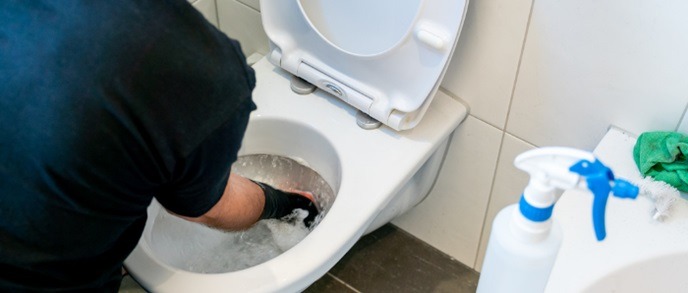Identify and address issues immediately if your toilet leaks, makes strange noises, or shows any indication of being blocked quickly. By taking this action, you’ll stop other issues from developing and ultimately save time and money.
Fixing those toilet issues pronto can save you a lot of hassle later on! For more tips and solutions, check out https://www.fullspeedplumbing.com/services/toilets/.
Clean the bowl
Ordinarily, toilet bowls need to be scrubbed because they are among the dirtiest fixtures in a house. Be sure to use disinfectant wipes or spray, particularly on the handles and seats.
Mineral deposits left behind from hard water or rusty plumbing components can create difficult-to-remove stains in a toilet bowl, making cleaning it more challenging than expected. Use vinegar or natural-based toilet cleaner to address these stubborn stains by beginning at the rim and working your way all around, including around the drain hole opening, before finally flushing.
Remember to abide by proper waste disposal rules and flush only human waste, toilet paper, and trash in the toilet. Be especially wary not to flush feminine products such as cotton balls, swabs, diapers, or paper towels, which have caused frequent toilet clogs!
In addition, be sure to inspect the shut-off valve that controls water flow to your toilet; it is typically located underneath or behind and should easily turn. If not, this could indicate a leak between the tank and the bowl that should be repaired quickly.
Check the flapper valve
If the noise or leakage from your toilet’s flapper valve keeps you up at night, replacing its rubber seal may be just what’s needed to solve the problem and save water at once. Replacing an old rubber seal can be one of the most straightforward fixes possible and can even save money!
Your toilet tank’s flapper valve opens during flushing to let water gush in quickly and then closes to stop its flow when finished. Under normal circumstances, its lifespan should last ten years; however, exposure to chemicals or chlorine tablets could shorten that timeline significantly.
Start by turning off the water to your toilet and taking off its tank lid before inspecting a chain connecting the flapper arm to its handle that has some slack – tight chains could lift off of their flush valve seat; approximately 1/4 to 1/2 of slack should allow it to fit firmly onto its seat if possible; otherwise, it may indicate leakage or malfunction within its valve system.
Check the fill valve
A fill valve is responsible for filling up your toilet tank after each flush, and its malfunction can create many issues. For instance, if water keeps running out from under your toilet seat, it could indicate a problem with its functioning or with one of its seals.
A typical toilet features multiple seals, the most prominent being between its tank and overflow tube. If any of these seals break, water could leak out of the tank into your home – in such an instance, tightening or replacing its flapper should suffice to solve this issue.
Leaks in the fill valve can also be common. This could be caused by either a damaged valve seat or mineral sediment build-up in the tank. You can test a fill valve by turning off your water supply and taking steps such as removing its cap assembly and checking if any leakage exists.
If so, replace it immediately; alternatively, you could also clean its interior using an inverted coffee cup as you turn on the water to flush any debris away from its insides.
Avoid harsh chemical cleaners
Chemical cleaners promise to make scrubbing easier and eliminate stains, but they can eat away at your toilet, leading to more significant problems. Furthermore, many clog removers are highly corrosive and could wreak havoc with your pipes.
Leaks in toilets can be an often-overlooked source of damage in homes. Leaks often manifest in multiple spots on a fixture and should be checked frequently, though silent leaks might go undetected until your monthly water bill starts rising dramatically.
One way to prevent leaks is by flushing only human waste and toilet paper down the drain and installing a water softener to filter out harsh minerals that clog drains and compromise fixture components over time.
Avoid hard water
Many of the issues homeowners experience with toilets can be resolved through preventive maintenance. Some important tips include following waste disposal rules, regularly checking for leaks, and installing a water softener in your home.
Hard water accumulates in your toilets, creating unsightly stains and interfering with functionality. Furthermore, hard water causes minerals to build up in pipes, narrowing them and decreasing flushing or filling effectiveness. Installing a water softener as a long-term solution prevents these harmful minerals from accumulating further in both pipes and toilets.
